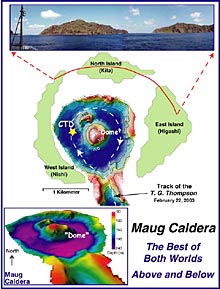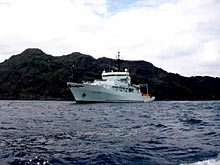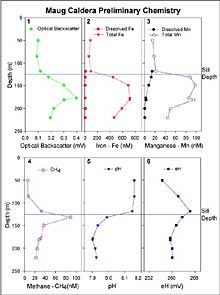
he bathymetry map in the center of the image shows the location of the CTD cast in the Maug caldera. Click image for more information and larger view.
The Thomas. G. Thompson Explores Maug Caldera
February 24, 2003
Bob Embley, Geologist
Pacific Marine Environmental Laboratory, NOAA
Joe Resing
Marine Chemist, University of Washington
Bill Chadwick
Volcanologist, Oregon State University
![]() View a panorama of island Maug. (mp4, 510 KB)
View a panorama of island Maug. (mp4, 510 KB)
There are more than 30 active volcanoes in the northern part of the Mariana Arc. Nine of these protrude above the ocean surface as islands. What does it mean to say a volcano is “active”? In general, this means that there is evidence that it erupted within the last 10,000 years, and therefore could potentially erupt again. Many of the Mariana volcanoes have been active in historical times. However, some volcanoes can lie dormant for hundreds of years between eruptions.
During our surveys, we have passed within a few miles of many of the islands of the northern Mariana Arc and have seen lava flows and other volcanic structures within close range. Maug Islands was of particular interest to us because it consists of several islands arranged in a circular pattern around a large depression called a caldera. Calderas result from the collapse of the top of the volcano when magma is removed from below, often during large explosive eruptions.
These eruptions can be spectacular, and, in extreme cases, catastrophic. The eruption of Krakatoa in 1883 was heard 2,200 miles away in Australia, and its ash cloud rose so high into the stratosphere that it affected sunsets for more than a year. Indeed, such eruptions can cause short-term climatic change. Crater Lake in southern Oregon was created about 7,000 years ago by a giant explosive eruption. Mount St. Helens is a more recent example, although its eruption was relatively small compared to either Krakatoa or Crater Lake.

The research vessel Thomas G. Thompson surrounded by Maug's three islands. The island in the background is the north island of Kita. Click image for larger view.
The enclosed nature of the Maug caldera was also an enticing target in our search for hydrothermal systems because a plume of mineral-rich water would be trapped in the deep part of the caldera below the shallowest depth (called the sill depth) where fresh ocean water can enter the depression. Although Maug is considered a dormant volcano, the presence of a hydrothermal system would at least show that there was still hot rock or possibly magma below it.
We entered Maug Caldera on the afternoon of February 22, and it is truly a spectacular place. As we all looked at the walls of this huge crater (about 1 mile across), we lowered our instruments into it and mapped the submerged portion with the Thompson’s EM300 multibeam system.
Did we find a hydrothermal plume in Maug?
Although the results are inconclusive, we did find an unusual series of anomalies in the Maug caldera that might very well indicate the presence of geothermal springs. Additional analyses back in the lab will help to clarify our results. We found the chemistry of the waters at Maug to be perhaps the most intriguing of the cruise to date. Our initial result of a large optical backscatter signal (i.e., cloudy water) peaking some 50 meters above the bottom of the caldera strongly suggested the presence of a hydrothermal plume. This observation was supported by large concentrations of methane, total (particulate plus dissolved) iron, and total manganese, while a large drop in pH hinted at volcanic carbon dioxide acidifying the seawater in the caldera.

These six graphs represent profiles of different chemical and physical tracers versus depth. Click image for larger view.
Confounding these results was the relative absence of dissolved manganese in the particle layer. Hot water liberates manganese from the volcanic rocks, and this manganese is dissolved in the water and slowly forms particles. The fact that we were able to filter almost all the manganese from the water means that it had already formed particles and was therefore somewhat old (weeks to months?). The elevated methane, while a promising indicator of hydrothermal activity, might also be generated from the decay of biological materials inside the caldera (Maug is teeming with bird life). A definitive test for active hydrothermal venting will be measurements of helium isotopes, but this analysis must wait until samples are returned to our shore-based laboratory.
The presence of countless seabirds on the three pinnacles that form the island of Maug provide a steady source of nutrients and organic matter to the caldera waters. These organic materials, combined with hydrothermal heat, nutrients, and organisms, may yield an extraordinary and unique ecosystem.
The floor of Maug caldera contains a lava dome that represents the regrowth of the volcano since its last major eruption (which formed the caldera). Samples of the lava dome taken by previous investigators are very similar in composition to the lava dome that formed in the crater of Mount St. Helens after the 1980 eruption!
Our data suggests that Maug is not deceased, but merely sleeping.

















